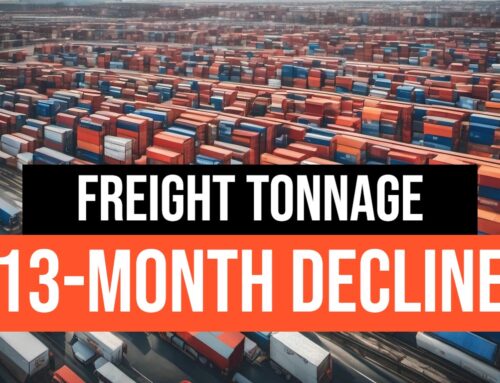Table of Contents
In the midst of the ongoing freight recession, the trucking industry finds itself in a whirlwind of change and uncertainty. As the United States grapples with the implications of the freight recession, it becomes increasingly crucial for trucking companies and owner operators to remain vigilant, adaptable, and well-informed.
Carriers and the Freight Recession

The experts at ‘Motive‘ came upon a noteworthy phenomenon – carriers that own six or more trucks are grappling with an unexpected surge in departures, ranging from 12% to a staggering 17% during July alone. This mass exodus trend, characterized by a fleet of this magnitude, isn’t showing signs of abating anytime soon, thereby setting a complex stage for the industry’s future. However, it’s important to recognize that beneath the challenges posed by such contractions, there often lies fertile ground for opportunities to germinate. History has shown that these phases of contraction often precede periods of rate hikes, hinting at the potential for industry transformation.
One of the opportunities that may arise from the industry contraction is the increased demand for smaller and more agile carriers, who can adapt to the changing market conditions and customer preferences. According to a report by ‘Motive’, carriers with one to five trucks have seen a 4% increase in their market share since January 2023, while carriers with six or more trucks have lost 7% of their share. This indicates that smaller carriers are able to offer more competitive rates, faster delivery times, and better customer service than larger carriers, who are often burdened by higher fixed costs, lower utilization, and more complex operations.
Another opportunity that may emerge from the industry contraction is the potential for innovation and collaboration among the remaining and new carriers. As the market becomes more challenging and competitive, carriers will need to find ways to differentiate themselves and create value for their customers. This may involve investing in new technologies, such as autonomous vehicles, electric trucks, and blockchain platforms, that can improve efficiency, safety, and transparency in the industry. It may also involve forming strategic partnerships, alliances, and networks with other carriers, shippers, brokers, and service providers, that can enhance their capabilities, expand their reach, and increase their profitability.
What DAT Trendlines Tell us

However, this isn’t the entire story. The data gleaned from DAT Trendlines presents a somber picture, indicating a notable 19.5% drop in spot market postings from June to July. This decline becomes even more glaring when compared to the numbers from July 2022, registering a staggering 50.3% decrease. What these figures reveal is a stark asymmetry – the number of available trucks now far surpasses the demand for freight.
The drop in spot market postings reflects the slowdown in the overall freight demand, which is influenced by various economic and seasonal factors. According to the Bureau of Economic Analysis, the U.S. gross domestic product (GDP) grew at an annual rate of 6.5% in the second quarter of 2023, which was lower than the expected 8.4%. Some of the factors that contributed to the lower-than-expected growth include supply chain disruptions, labor shortages, inflation, and the resurgence of the COVID-19 pandemic. These factors have also affected the freight demand, as shippers have faced challenges in sourcing, producing, and distributing their goods. The imbalance between the supply and demand of trucks in the spot market has also resulted in lower spot rates.
According to DAT Trendlines, the national average spot rates for van, flatbed, and reefer trucks in July 2023 were $2.32, $2.85, and $2.68 per mile, respectively. These rates were lower than the rates in June 2023, which were $2.67, $3.07, and $3.09 per mile, respectively. The lower spot rates have reduced the profitability and attractiveness of the spot market for carriers, who may prefer to secure more stable and higher-paying contracts with shippers.
A Sliver of Optimism

Intriguingly, amid these challenges, there’s a sliver of optimism. Tender volumes for reefer and flatbed freight have ascended to unprecedented levels, setting new records for the month of July. This data complexity underscores the intricate nature of the current economic milieu. On the flip side, an analysis by Cass Information Systems serves as a stark reminder – the ongoing downcycle within the industry has already spanned a daunting 19 months.
The rise in tender volumes for reefer and flatbed freight indicates that there is still strong demand for certain types of freight, especially those that are related to the food and beverage, construction, and manufacturing sectors. Thanksgiving is just around the corner so reefers can expect to haul a lot of frozen turkey, chicken, duck, geese, and other poultry. Flatbeds normally shine during the spring and summer months but since we now live in an upside-down world, flatbeds can expect to see a temporary increase in rates and freight availability through the end of 2023.
However, the optimism for reefer and flatbed freight may not be enough to offset the challenges faced by the overall trucking industry, which has been in a prolonged downcycle since 2022. According to the Cass Freight Index, which measures the volume and expenditures of shipments across multiple modes of transportation, the freight shipments and expenditures in July 2023 were 8.4% and 5.9% lower than the same month in 2022, respectively. The Cass Freight Index also shows that the freight shipments and expenditures have been declining year-over-year for 19 consecutive months, which is the longest streak of negative growth since the Great Recession of 2008-2009. The Cass Freight Index suggests that the trucking industry is facing a significant contraction, which may signal a broader slowdown in the U.S. economy.
Past, Present, and Future

Drawing lessons from historical patterns provides a window into the potential trajectory of the present freight recession. Historically, the last three downcycles have each endured for periods ranging from 21 to 28 months. This insight suggests that the current downturn may begin to show signs of waning or even conclude between October 2023 and May 2024.
However, historical patterns may not be reliable indicators of the future, as the current freight recession is influenced by unprecedented factors, such as the COVID-19 pandemic, the trade war, and the environmental regulations. These factors have created significant uncertainty and volatility in the market, which may prolong or worsen the downturn. According to a report by FTR Transportation Intelligence, the trucking industry may not see a meaningful recovery until late 2024 or early 2025, as the supply and demand imbalances persist and the freight rates remain depressed. The report also warns that the industry may face another recession in 2026, as the economic cycle enters a new phase of contraction.
Therefore, the trucking industry needs to prepare for the possibility of a longer and deeper freight recession, and adopt strategies that can help them survive and thrive in the challenging market. Some of the strategies that the industry can consider include diversifying their customer base, optimizing their fleet size and utilization, reducing their operating costs, improving their cash flow, enhancing their service quality, and investing in innovation and technology. By implementing these strategies, the trucking industry can increase its resilience and competitiveness, and position itself for future growth and success. Luckily these are the very metrics that we at AFT Dispatch have been helping our customers improve.
What Lies Ahead for Trucking

As we anticipate the potential upswing in freight levels with new trucks entering the market, an air of uncertainty still hovers. This is evidenced by the significant 15% drop in truck visits to the top-50 retailer warehouses in July, reflecting the industry’s ongoing challenges.
This a sign of the industry’s ongoing challenges, but it is not the whole story. According to a report by Motive, the trucking visits to the top-50 retailer warehouses surged by 3% in the week leading up to July 4th, marking a 9% jump since a slower-than-average Memorial Day Weekend. This was the first bright spot for retail and freight demand in 2023, and it may indicate a stronger than expected Independence Day surge in consumer spending.
However, the report also cautions that the increase in retail freight traffic in July was still well below the heights seen in previous years, and that the retailers continue to adopt a “wait-and-see” approach in the current environment, suggesting a cautious outlook for consumer demand in the second half of the year. Moreover, the report notes that the trucking visits to the top-50 retailer warehouses typically peak in the second to last week before July 4th, but this year, the peak came in the last week before the holiday. This means that the retailers are bringing in inventory much later than usual, which is consistent with the behavior observed during the 2022 Christmas holiday season. This may imply that the retailers are facing supply chain disruptions, labor shortages, inflation, and the resurgence of the COVID-19 pandemic, which have affected their sourcing, producing, and distributing their goods.
Projections and Possibilities

Predictions point to the freight recession persisting through the entirety of 2023, a dynamic where the manufacturing sector contracts even as the consumer segment continues to display vitality. Amidst this backdrop, there’s a glimmer of optimism. ACT Research suggests that demand fundamentals might experience an upturn sooner than initially anticipated.
The freight recession is expected to last throughout 2023, as the manufacturing sector shrinks and the consumer sector remains resilient. However, there is some hope for a turnaround in the near future, according to ACT Research, a firm that tracks the trucking industry. ACT Research suggests that the demand fundamentals are improving, and that the freight market may have reached its bottom.
ACT Research has revised its economic and trucking forecasts, and is now modeling a recession in the first half of 2023, but flat for the full year. The firm has also adjusted its expectations for the Class 8 market, with higher sales in 2022 and lower sales in 2023 and 2024. The firm predicts that truckload and intermodal contract rates will fall this year due to overcapacity and weak freight demand, but will recover in the second half of 2023. The firm acknowledges that the current freight recession is influenced by unprecedented factors, such as the COVID-19 pandemic, the trade war, and the environmental regulations, which have created significant uncertainty and volatility in the market. However, the firm also sees some positive signs, such as higher consumer spending on services, increased home sales, and reduced trade tensions.
Strategic Thinking During a Freight Recession

While the industry seems to be navigating the current trough, it’s important to highlight that the situation isn’t projected to deteriorate significantly in the near term. In this challenging landscape, prudent operation and resource management are crucial. Carriers equipped with a well-structured business plan are better poised to weather the storm compared to those without such strategic foresight. The attributes of strategic thinking, and a focus on the long-term hold the key to traversing these turbulent times successfully.
Strategic thinking is the ability to analyze the current situation, identify the opportunities and threats, and formulate a vision and a plan for the future. Strategic thinking helps carriers to align their goals, resources, and actions with the changing market conditions and customer expectations. It also helps carriers to anticipate and mitigate the risks, and leverage their strengths and competitive advantages. According to a report by McKinsey & Company, strategic thinking is one of the most important skills for leaders in the transportation and logistics industry, as it enables them to create value and achieve sustainable growth.
A focus on the long-term is another essential attribute for carriers in the freight recession, as it helps them to avoid short-sighted decisions that may compromise their future performance and potential. A focus on the long-term means that carriers invest in their core capabilities, such as their fleet, their drivers, their technology, and their customer relationships, and seek to improve their efficiency, quality, and innovation. It also means that carriers diversify their revenue streams, expand their market share, and explore new opportunities for growth. According to a study by the American Trucking Associations, carriers that focus on the long-term are more likely to survive and thrive in the cyclical and competitive trucking industry, as they can adapt to the changing demand and supply dynamics and create a loyal customer base.

We’re Here to Help!
In our commitment to provide insights amid these uncertain times, we’re here to guide you. Subscribing to our YouTube channel ensures you’re always connected to evolving industry trends, insightful analyses, and strategic approaches. Together, let’s navigate the complexities of this freight recession and emerge even stronger on the other side. By staying well-informed and adaptable, your trucking business can not only weather the current challenges but also seize opportunities to thrive in the evolving industry landscape.
The Intricate Freight Ecosystem
 It’s important to recognize the multi-faceted nature of the freight industry. As the recession tightens its grip, the repercussions reverberate through various facets of the trucking ecosystem. The very essence of the trucking industry hinges on the interplay between carriers, shippers, brokers, and drivers. The intricate dance of supply and demand has, for years, determined the rhythm of the industry. However, the tune seems to have changed, at least for now.
It’s important to recognize the multi-faceted nature of the freight industry. As the recession tightens its grip, the repercussions reverberate through various facets of the trucking ecosystem. The very essence of the trucking industry hinges on the interplay between carriers, shippers, brokers, and drivers. The intricate dance of supply and demand has, for years, determined the rhythm of the industry. However, the tune seems to have changed, at least for now.
The multi-faceted nature of the freight industry means that the recession affects different segments of the trucking ecosystem in different ways. The carriers, shippers, brokers, and drivers all have their own challenges and opportunities in the current market, and their interactions and relationships are constantly evolving. The supply and demand balance, which has traditionally determined the rates and revenues in the industry, has shifted in favor of the shippers, who have more bargaining power and options than the carriers, who are facing overcapacity and weak demand.
Uncertainty in the Digital Age

Amid the clamor of contrasting data points, there’s a constant: uncertainty. This uncertainty, while daunting, is not unfamiliar to seasoned industry players. The cyclical nature of the freight market has long been a reality, a pendulum swinging between periods of plenty and want. What differentiates these cycles, however, is the context in which they unfold.
The context in which the current freight recession unfolds is unprecedented and complex, as it is influenced by various factors, such as the COVID-19 pandemic, the trade war, the environmental regulations, the labor shortages, the supply chain disruptions, and the consumer behavior changes. These factors have created significant uncertainty and volatility in the market, which have affected the freight demand, supply, rates, and revenues. According to a report by FreightWaves, the freight recession is expected to last until the end of 2023, but it may be followed by a strong recovery in 2024, as the economy rebounds and the freight market stabilizes. The report also suggests that the freight recession may be a necessary correction for the industry, as it helps to eliminate the excess capacity and inefficiency that were created during the pandemic demand spike.
Thriving in the Face of Challenges

The current scenario unfolds against the backdrop of global events, economic intricacies, and technological revolutions. The ongoing pandemic continues to cast its shadow, shaping consumer behavior, supply chain dynamics, and market sentiments. The ripple effect of these factors can’t be underestimated. The digital age has ushered in an era of unprecedented connectivity, accelerating the pace of information exchange, and shifting the dynamics of decision-making.
These factors have also created new challenges and opportunities for the freight industry, as it has to adapt to the changing demand and supply of goods, the evolving customer expectations, and the emerging technologies. According to a report by Deloitte, the freight industry is undergoing a digital transformation, which can enable the industry to improve its efficiency, agility, and resilience, and to create new value propositions and business models. The report also identifies four key drivers of the digital transformation in the freight industry: the customer-centricity, the data-driven insights, the platform-based ecosystems, and the intelligent automation. The report suggests that the freight industry needs to embrace these drivers and leverage the digital technologies, such as the cloud, the internet of things, the artificial intelligence, and the blockchain, to enhance its performance and competitiveness in the current scenario.
Writing the Future Amidst Challenges

Amidst the ebb and flow of data points and trends, it’s crucial to hold onto perspective. History has shown that downturns, while challenging, often provide fertile ground for innovation and transformation. Companies that adapt swiftly, embracing change as an opportunity, are more likely to navigate the stormy waters successfully.
This is especially true for the freight industry, which is undergoing a digital transformation, driven by new technologies, such as artificial intelligence, blockchain, and autonomous vehicles. These technologies can create new opportunities and challenges for the carriers, the shippers, the brokers, and the drivers, and enable them to improve their efficiency, agility, and resilience.
According to the earlier mentioned report by Deloitte, the freight industry can leverage these technologies to enhance its performance and competitiveness in the current scenario, and to create new value propositions and business models. The report also identifies four key drivers of the digital transformation in the freight industry: the customer-centricity, the data-driven insights, the platform-based ecosystems, and the intelligent automation. The report suggests that the freight industry needs to embrace these drivers and invest in the digital capabilities, the talent development, and the innovation ecosystems.
Empowering Your Business with Strategic Partnerships

So, what’s the bottom line for trucking companies in these uncertain times? Strategic thinking is paramount. It’s not just about weathering the storm but positioning oneself for the inevitable upturn. While the industry might be in the throes of contraction, opportunities for growth and transformation persist.
Strategic partnerships can take various forms, such as joint ventures, alliances, networks, platforms, and ecosystems. Each form has its own benefits and challenges, and requires different levels of commitment, collaboration, and integration. Trucking businesses need to carefully evaluate their goals, resources, and risks, and choose the form that best suits their needs and expectations. Trucking businesses also need to identify and select the right partners, who share their vision, values, and objectives, and who can complement their strengths and compensate their weaknesses. Trucking businesses need to establish clear and mutually beneficial agreements, and maintain trust and communication with their partners, to ensure the success and sustainability of their strategic partnerships.

The freight recession is not just a chapter in the trucking industry’s history; it’s a defining moment. The challenges it poses are matched only by the opportunities it holds. As the road stretches into the unknown, remember that while the journey might be tough, it’s the challenges that mold greatness. As the industry navigates these uncharted waters, those who chart a course with strategic insight, adaptability, and unwavering determination will not only overcome the challenges but also emerge as torchbearers guiding the industry toward a brighter future.
This is where AFT Dispatch comes into play. With our industry-leading truck dispatch service, we offer a beacon of support to motor motor carriers and owner operators alike. Our team of expert truck dispatchers is equipped to tackle the intricate web of challenges that define today’s trucking landscape, providing tailored solutions that maximize efficiency and profitability.
Don’t let the complexities of the current environment hold you back – come see how we at AFT Dispatch can be your strategic partner and discover how our services can revolutionize your operations. Call or text us at (801) 448-6363. We’d also like to encourage you to look through our vast library of free educational trucking videos which have proven to be very useful to other truckers just like you.






[…] as shippers scramble to find alternative routes and modes of delivery. This has created a golden opportunity for trucking companies and truck drivers, who can benefit from the rising rates and the increased demand. However, this […]
[…] you tired of spending endless hours scouring load boards and settling for for meager rates that barely cover your fuel costs? Do you want to transform your trucking business and maximize your […]
[…] for trucks is one of the most important and challenging tasks for any owner operator. You need to find the best freight opportunities that match your truck type, location, schedule, and rate. You also need to deal with different […]
[…] proposed tax package for truckers might seem like a treasure trove of good news, but navigating the complexities requires a cautious approach. Let’s delve deeper to understand the potential impact on your […]
[…] a recession does materialize in 2024, it could have a significant impact on the trucking industry. Here are some potential […]
[…] profitable loads and keeping your trucks rolling. Imagine the time saved translating into more strategic planning, driver communication, or exploring new market […]